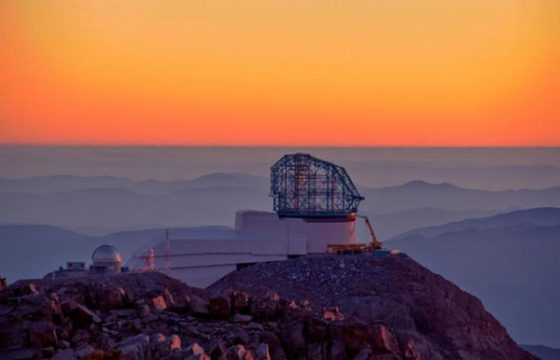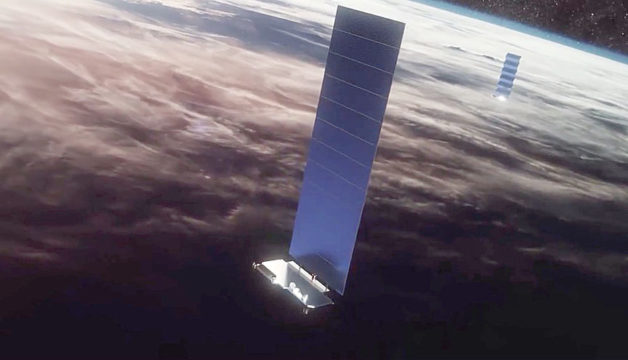Concerns about the night sky remain as the fourth batch of Starlink satellites — and the second one to be launched within the span of a month — takes flight.
The fourth batch of Starlink satellites took to the skies on January 28th at 9:28 EST (14:28 UTC). That brings the total number of Starlink satellites in orbit to 240 — delighting prospective internet users and dismaying many in the astronomical community.
Watch the launch here:
SpaceX is assembling the Starlink megaconstellation with the aim of providing high-speed broadband internet to places where access has been unreliable, expensive, or completely unavailable. The initial constellation consists of 1,584 satellites, and SpaceX wants to put the bulk of those into space by the end of 2020. Ultimately, SpaceX intends to put on the order of 40,000 satellites into low-Earth orbit, raising concerns about the night sky and the ability to do research astronomy.
"The new satellites are brighter than virtually all of the 18,000 objects in the public catalog," says Patrick Seitzer (University of Michigan). "Which is itself incomplete!"
Darksat: A Darker Starlink Satellite
Concerns about the satellites' brightness are being addressed, in part, in ongoing communications between SpaceX and professional astronomers, as well as members of the American Astronomical Society (AAS) and International Astronomical Union staff. As part of this arrangement, astronomers are contributing observations of the Starlink satellites in order to understand what effect these satellites will have on research astronomy.
Those observations will prove crucial for one satellite in particular, dubbed “Darksat.” Launched on January 7th, Darksat has a special coating designed to darken parts of the satellite so that they don’t reflect or scatter the sunlight so strongly. This strategy is one of only a few mitigation strategies available to SpaceX that don't significantly alter the satellite design or constellation configuration.
“The expectation is for a few magnitudes of V-band dimming (thus dropping it below naked eye limit),” says Joel Parriott (AAS), “but the proof is in the pudding.”
The pudding will still take a few weeks to cook: The satellites launched on January 7th are still using their krypton-fueled plasma thrusters to raise their orbits from the deployment orbit at 290 kilometers (180 miles) to their operational altitude at 550 km. Until then, the satellites’ solar panels are positioned to reduce drag.
As a result, for now Darksat appears as bright as its compatriots — see, for example, Thierry Legault’s video of the satellite train:
The satellites are expected to reach operational altitude, and then change the orientation of their solar panels, in mid- to late-February.
Other Options for Mitigation
If the dark coating works, it will likely have the most impact for stargazers, as it promises to take the satellites out of the range of naked-eye visibility.
Even at a few magnitudes fainter, though, the satellites will still be plenty bright enough — and most importantly, numerous enough — to wreak havoc on the extremely sensitive detectors used in professional astronomical observations. Potential problems include saturated pixels, cross-talk between pixels, and ghost images, says Seitzer, who is involved in astronomers’ telecons with SpaceX.
Darkening the satellites is one of two mitigation strategies that the company is currently pursuing, SpaceX’s Patricia Cooper told a roomful of astronomers at the recent AAS meeting in Honolulu.
SpaceX is also working to provide astronomers with exact orbital elements, Cooper added, so that astronomers can simply avoid the satellites altogether. That’s possible for some observatories, but avoiding thousands of satellites will hamper observatories with wide fields of view and sensitive detectors (such as the Vera C. Rubin Observatory, formerly LSST), as well as those that target twilight times for observing (such as robotic telescopes sweeping the sky for potentially hazardous asteroids).

LSST Corporation
For this reason, scientists and engineers at Vera Rubin Observatory are working to reduce the artifacts from the telescopes’ readouts. It’s not an easy task, as the detectors are designed to spot some of the faintest objects that can be seen from the ground.
For this reason, scientists and engineers at Vera Rubin Observatory are working to reduce the artifacts from the telescopes’ readouts. It’s not an easy task, as the detectors are designed to spot some of the faintest objects that can be seen from the ground.
SpaceX isn't the only company launching satellites. OneWeb has a launch currently scheduled for February 6th, and Amazon's Kuiper Project also involves launching several hundred satellites. Talks between these companies and professional astronomers are beginning as well.
But Starlink will be by far the biggest satellite megaconstellation by a couple orders of magnitude, if all goes according to SpaceX's plan. Even without results from its Darksat in hand yet, SpaceX currently has two more launches of 60 satellites each set for February.
Read more about how astronomers are making sense of how megaconstellation satellites will affect our skies in the March issue of Sky & Telescope.
 4
4










Comments
You must be logged in to post a comment.